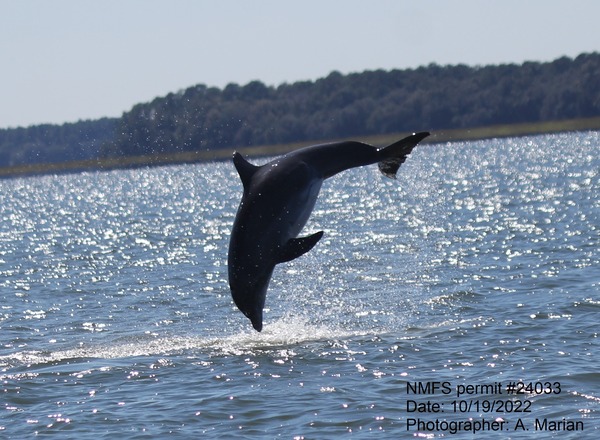News from USCB’s Marine Sensory and Neurobiology Lab

USCB’s Marine Sensory and Neurobiology Lab collects data in local waterways, including the May River, to analyze key behaviors of marine animals. NMFS permit #24033.
Dr. Eric Montie, his staff and student researchers have been hard at work at USCB’s Marine Sensory and Neurobiology Lab, where they have embraced new projects and reached an important milestone.
Montie is an associate professor of Biology in USCB’s Department of Natural Sciences, director of the University’s Marine Sensory and Neurobiology Lab, and director of the Lowcountry Dolphin Conservation Program.
This month marks a decade of collecting estuarine soundscape data in the May River for Dr. Montie, his lab assistant Alyssa Marian, and undergraduate and graduate student researchers. This effort is part of the Estuarine Soundscape Observatory Network in the Southeast (ESONS), funded by NOAA’s Integrated Ocean Observing System (IOOS) and the Southeast Coastal Ocean Observing Regional Association (SECOORA).
Montie and his team collect recordings of underwater soundscapes from nine recorders placed in four different estuaries throughout South Carolina. The devices listen to bottlenose dolphins, snapping shrimp and fish species such as black drum, red drum and spotted sea trout. The recordings provide information on spawning and foraging patterns, dolphin communication, and noise levels associated with human activity. The long-term goal is to ‘eavesdrop’ on key behaviors of marine animals that can shift rapidly or gradually in response to environmental changes and human impacts. Over time, these data provide a measure of resilience or shifting baselines in the Lowcountry’s changing environment.
“Being part of this project has given me a sense of an ongoing community of researchers that I've never met, but we are connected all the same,” said Anneau Cappelmann, a biology major and assistant in Montie’s lab. “The collaborative aspect of our research creates a foundation to understand estuarine ecology over time and space, which I believe is increasingly important as we experience climactic variability and growing human alteration.”
The USCB team’s efforts have gained global traction. They have been invited to join the Global Library of Underwater Biological Sounds at the Australian Institute of Marine Science. Dr. Montie is collaborating with the institute’s Miles Parson to design a web-based platform that will help scientists share knowledge, promote
awareness of the importance of underwater sound, and provide a standardized and IQOE-endorsed method to process and view these data. He will be a co-author of a forthcoming manuscript about this initiative.
“I am thrilled that our dataset is contributing to this global library,” said Computational Science graduate student Patrick Jones, who Dr. Montie serves as his major advisor, “I believe that partnership will help solidify our work internationally and provide knowledge for future generations.”
Dr. Montie’s lab also has a new project in collaboration with Dr. Lynn Leonard at UNCW that is funded by the U.S. Department of Transportation Maritime Administration (DOT MARAD). The project will determine the source levels of large container ships passing through the Cape Fear Shipping Channel off the coast of NC. This project will use high-tech, underwater sound devices to measure the noise emitted from ships that vary in speed and engine type. The eventual goal is to provide data to MARAD on ship noise profiles, so quieter ship technology can be identified. These data will provide a framework for future DOT MARAD projects to better understand and manage underwater noise impacts on marine life.
"I am excited to be a part of our new project to measure ship noise because we will hopefully get a better understanding of how noisy shipping actually is underwater and what that means for the biological communities in our oceans and estuaries,” said Alyssa Marian, manager of USCB’s Marine Sensory and Neurobiology Lab. '“I think this project could have a major impact nationally and internationally."
“I have worked with an amazing team of students and research scientists over the last 10 years,” says Montie, “we are so happy that NOAA IOOS/SECOORA continue to support and fund this work to create a long-term, ecological dataset that focuses on the biological sounds and human-made noise of estuaries, what we call the Estuarine Soundscape Observatory Network in the Southeast (ESONS). Over the coming year, our goal is to integrate ESONS data into the NOAA IOOS / SECOORA portal (https://ioos.noaa.gov/data/regional-data-portals/). This way, the data will never be lost and can be used by the entire research community to answer important questions on climate change, changing levels of human-based noise, and other stressors on the health of our estuaries. We are also very excited for scientists to use our dataset for machine learning/AI purposes, which will move these computational approaches to the field of marine science.”